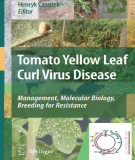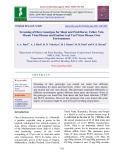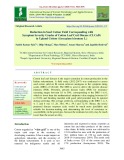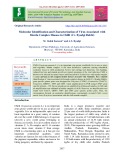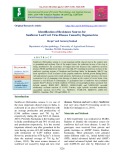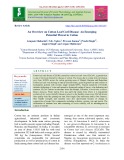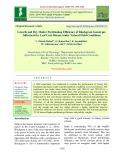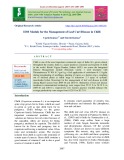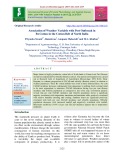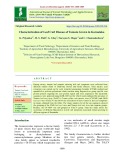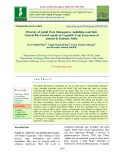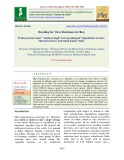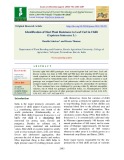
Leaf curl disease
-
Ebook "Tomato yellow leaf curl virus disease: Management, molecular biology, breeding for resistance" will awaken the interest of breeders, phytopathologists, environmentalists, extension services, plant virologists, entomologists and molecular biologists. It deals both with the epidemiological aspects of the disease and with integrated pest management in the field. It discusses the efforts aimed at breeding tomato plants resistant to the virus (using classical breeding, marker-assisted breeding and genetic engineering).
 437p
437p  ladongphongthanh1008
ladongphongthanh1008
 22-04-2024
22-04-2024
 2
2
 2
2
 Download
Download
-
Cotton leaf curl disease (CLCuD), caused by begomoviruses in association with satellite molecules, is a major threat to cotton production causing enormous losses to cotton crop in most of the cotton growing countries including Indian subcontinent.
 13p
13p  visilicon2711
visilicon2711
 20-08-2021
20-08-2021
 5
5
 1
1
 Download
Download
-
The present study was aimed to identify spatial distribution of chilli leaf curl disease in chilli growing districts of Northern Karnataka. In order to support the studies of its epidemiology, collection of information related to cropping system, soil type and weather conditions which are pre-requisite to take final decision on sustainable disease management practices were also considered.
 7p
7p  trinhthamhodang11
trinhthamhodang11
 27-04-2021
27-04-2021
 7
7
 1
1
 Download
Download
-
Screening of okra genotypes was carried out under four different environments for shoot and fruit borer, yellow vein mosaic virus disease and enation leaf curl virus disease. The genotypes responded differently to different environments against different insect-pests and diseases. None of the genotype was found free from shoot and fruit borer infection, YVMV and ELCV incidence. However the genotypes that were found with some degree of resistance might be used for future breeding programmes.
 11p
11p  trinhthamhodang11
trinhthamhodang11
 27-04-2021
27-04-2021
 12
12
 1
1
 Download
Download
-
Cotton leaf curl disease is the major constraint in cotton production in the Indian subcontinent. A field study (2012-2017) was conducted to assess seed cotton yield on Bt cotton cultivars analogous to the symptom rating scales (DRS) of CLCuD. The DRS is used to derive the percent disease intensity (PDI).
 14p
14p  caygaocaolon11
caygaocaolon11
 21-04-2021
21-04-2021
 12
12
 1
1
 Download
Download
-
Chilli (Capsicum annuum L.) is an important crop grown worldwide for its use as spice and vegetable. Murda complex is the most destructive syndrome causing substantial economic losses in chilli production. Severe leaf curling, leaf distortion, vein banding, reduced leaf size and stunted growth are typical symptoms of the viral infection. Chilli is known to be infected by many viruses and association of Geminivirus with murda complex is under question as the complex disease doesn’t associate with whiteflies.
 8p
8p  nguaconbaynhay10
nguaconbaynhay10
 22-01-2021
22-01-2021
 12
12
 2
2
 Download
Download
-
Sunflower (Helianthus annuus L.) is an important edible oilseed crop in the country next to groundnut and soybean. One of the major factors for reduction in area of the crop is being attributed to the occurrence of fungal and viral diseases like sunflower necrosis disease (SND) and Sunflower leaf curl virus (SuLCV) resulting in yield loss in most of the sunflower growing regions of Southern and Northern India. In Karnataka, SuLCV has been reported to occur in almost all the popular sunflower hybrids grown during kharif, rabi and summer seasons with varied intensity.
 5p
5p  cothumenhmong9
cothumenhmong9
 04-01-2021
04-01-2021
 9
9
 1
1
 Download
Download
-
Cotton leaf curl disease (CLCuD) caused by cotton leaf curl virus (CLCuV), a geminivirus is one of the most destructive disease of cotton. The losses due to cotton leaf curl disease vary from 10-90% across the cotton growing areas of Punjab, Haryana and Rajasthan. Cotton leaf curl virus belongs to family Geminiviridae, genus begomovirus and consists of monopartite genome with circular, single stranded DNA.
 9p
9p  gaocaolon9
gaocaolon9
 22-12-2020
22-12-2020
 7
7
 1
1
 Download
Download
-
A field experiment was conducted to evaluate the performance of twenty five blackgram genotypes under naturally epidemic conditions to leaf curl disease. The experiment was under taken during the late rabi 2018-19 and 2019-20 in a randomized block design replicated thrice. The investigation has focused on the study of variation in the dry matter production efficiency of the genotypes as influenced by leaf curl disease infection.
 11p
11p  trinhthamhodang1216
trinhthamhodang1216
 19-11-2020
19-11-2020
 10
10
 2
2
 Download
Download
-
Chilli is one of the most important commercial crops of India. It is grown almost throughout the country. India is a major producer, consumer and exporter of chilli in the world. Krishi Vigyan Kendra, Sehore (M.P.
 5p
5p  caygaocaolon8
caygaocaolon8
 07-11-2020
07-11-2020
 13
13
 1
1
 Download
Download
-
Major threat to highly productive cotton belt of North India is Cotton Leaf Curl Disease exclusively transmitted by whitefly (Bemisia tabaci). The present investigation was carried out at Research farm of department of Agricultural Meteorology, CCS HAU, Hisar Haryana, to evaluate progression of CLCuD and whitefly (Bemisia tabaci) in relation to weather parameters. Three Bt -cotton hybrids were sown at three different dates. Per cent CLCuD incidence increases continuously from appearance to picking.
 13p
13p  trinhthamhodang1215
trinhthamhodang1215
 23-09-2020
23-09-2020
 14
14
 1
1
 Download
Download
-
In the present investigation different biological and chemical elicitors have been used to check their resistance developing efficacy against TYLCD.
 7p
7p  caygaocaolon7
caygaocaolon7
 18-09-2020
18-09-2020
 9
9
 2
2
 Download
Download
-
This is because the incidence and spread of a single virus disease may be dependent on several vectors which have complicated ecologies themselves (Bos, 1986). Whitefly (Bamasia tabaci) transmitted cotton leaf curl virus disease was the major problem in cotton cultivation (Sharma et al., 2006). However, weather has a very crucial role in CLCuD spread and development and also affects its vector whitefly’s ecology.
 8p
8p  cothumenhmong7
cothumenhmong7
 09-09-2020
09-09-2020
 13
13
 1
1
 Download
Download
-
High phenotypic coefficient of variation and genotypic coefficient of variation were observed for percent potato apical leaf-curl disease (PALCD) incidence at 40, 60 and 80 DAP, whitefly population at 20 and 30 DAE and phenols.
 17p
17p  trinhthamhodang7
trinhthamhodang7
 31-08-2020
31-08-2020
 13
13
 2
2
 Download
Download
-
During survey, tomato leaf samples showing leaf curl symptoms were collected from different tomato fields of Dharwad, Haveri and Kolar districts. Total nucleic acid extraction was carried out by cetyl trimethyl ammonium bromide (CTAB) method and quantified to perform polymerase chain reaction using Begomovirus group specific coat protein primers targeting the coat protein region and were sequenced.
 6p
6p  caygaocaolon6
caygaocaolon6
 30-07-2020
30-07-2020
 10
10
 1
1
 Download
Download
-
The aphids (Homoptera: Aphididae) are one of major pests of agriculturally important crops, including vegetables, across the world. They suck plant sap, cause leaf curling, yellowing and stunted growth of the host plants. They also act as vectors of many viral diseases in plants. In order to explore aphid pests and their naturally occurring bio-control agents (parasitoids and predators), an extensive field survey was conducted in different vegetable ecosystems of the Kashmir valley during the years from 2014-2019.
 18p
18p  caygaocaolon6
caygaocaolon6
 30-07-2020
30-07-2020
 13
13
 2
2
 Download
Download
-
Tomato leaf curl disease caused by tomato leaf curl virus (ToLCV) is a major limiting factor in tomato cultivation in Jammu region of Jammu and Kashmir. Screening of different germplasm collected from different sources against the disease showed that out of fifteen germplasm, Mahaveer and Avinash-2 were found resistant, Samrudhi F1 and Namdhari 82535 were found moderately resistant while eleven germplasm viz. Heem Sohna, Sonali, Rupali, NS 816, NS 812, Pusa Ruby, Indus 1030, Arti, DVRT-2, Hybrid no. 15 and local showed susceptible reaction.
 7p
7p  trinhthamhodang6
trinhthamhodang6
 09-07-2020
09-07-2020
 11
11
 1
1
 Download
Download
-
Surveys were conducted during 2016-18 revealed that the occurrence of the leaf curl disease on tobacco in major growing districts of Karnataka ranged from 19.60 to 31.01 during 2016-18. Among the six districts surveyed, highest per cent disease incidence of tobacco leaf curl virus was recorded in Shivamogga district (31.01) followed by Belagavi (25.59) and lowest per cent disease incidence of 19.60 of TbLCV was recorded in Chamarajangar district. The survey data imply that leaf curl disease is emerging as one of the major diseases of tobacco.
 8p
8p  kethamoi5
kethamoi5
 03-06-2020
03-06-2020
 13
13
 1
1
 Download
Download
-
Okra [Abelmoschus esculentus (L.) Moench], is an important crop which is widely cultivated in different parts of the world mostly for human consumption and also for industrial use as fibre. The okra production in India, is hindered by occurrence viral diseases, like Yellow Vein Mosaic Virus (YVMV) disease and Okra Enation Leaf Curl Virus (OELCV) disease, spread by an insect vector, namely whitefly (Bemisia tabaci Gen), which affect okra production in terms of yield and fruit quality as well.
 13p
13p  caygaocaolon5
caygaocaolon5
 27-05-2020
27-05-2020
 13
13
 1
1
 Download
Download
-
Seventy eight bird chilli genotypes were screened against leaf curl virus. Leaf curl disease scoring was done at 30th, 60th and 90th days after planting (DAP) based on visual symptoms of each observational plant. Initial screening was done under field conditions based on vulnerability index score (0 to 4 scale), disease reaction to each genotype was assigned based on Leaf pubescence which can be observed on the youngest mature leaves and it was classified as sparse (3), intermediate (5) and dense (7).
 5p
5p  cothumenhmong5
cothumenhmong5
 17-05-2020
17-05-2020
 11
11
 0
0
 Download
Download
CHỦ ĐỀ BẠN MUỐN TÌM









